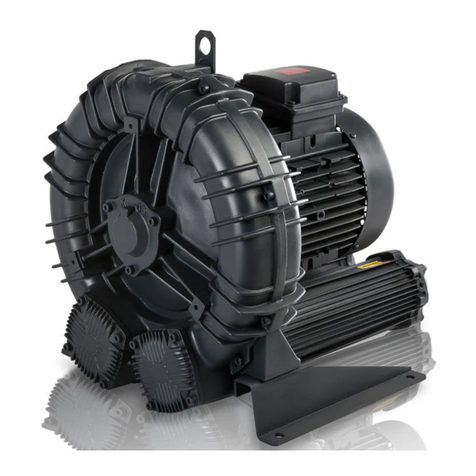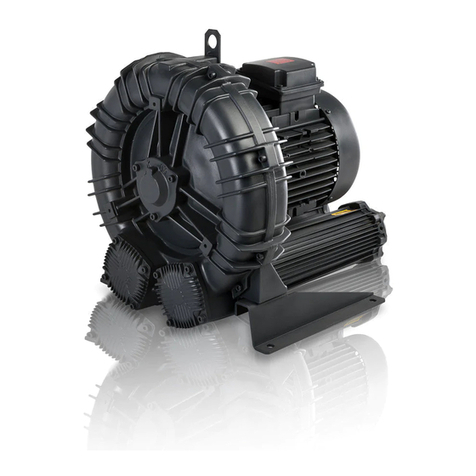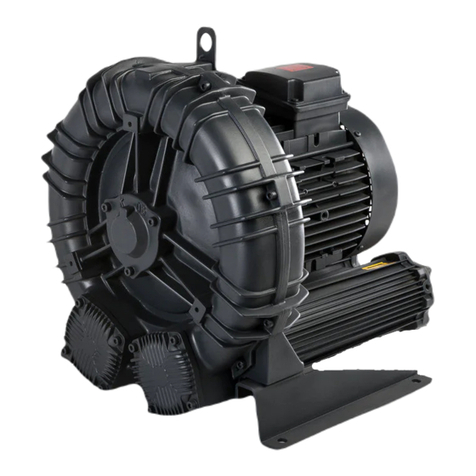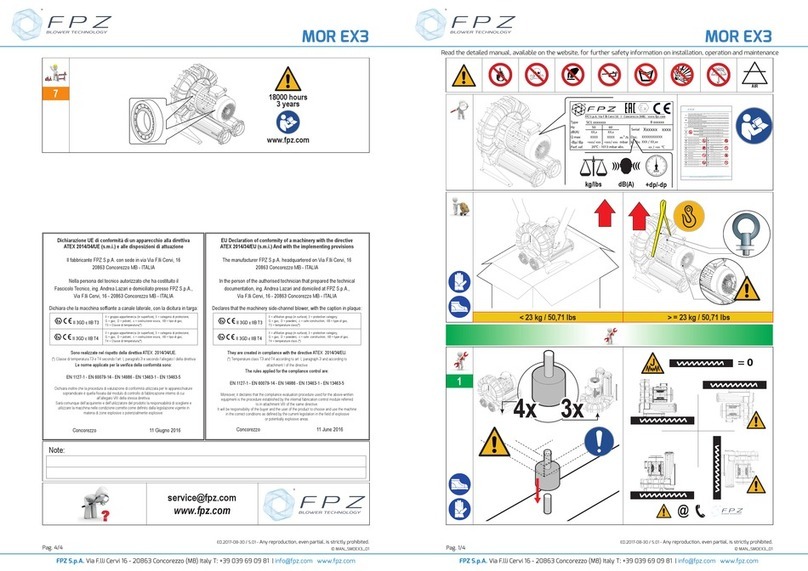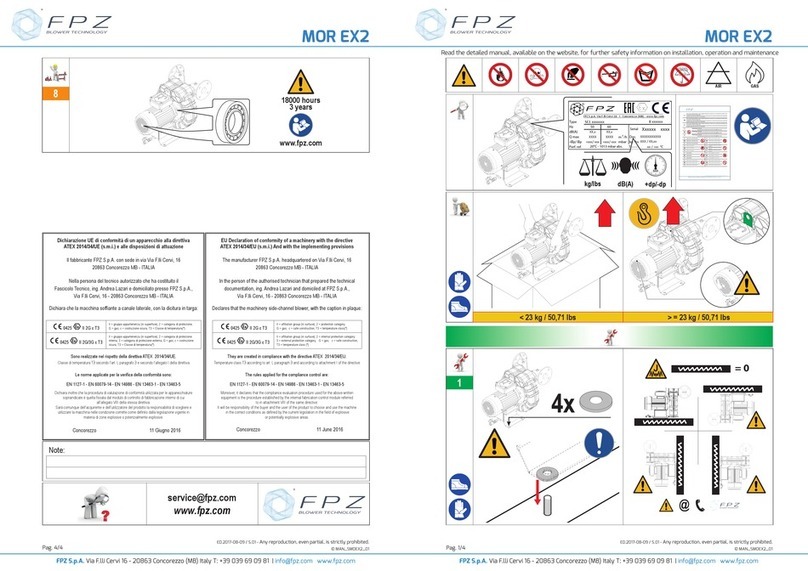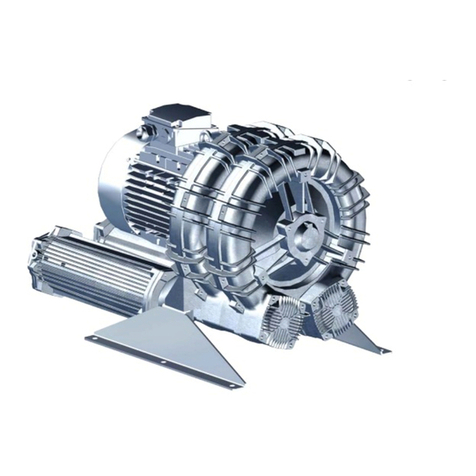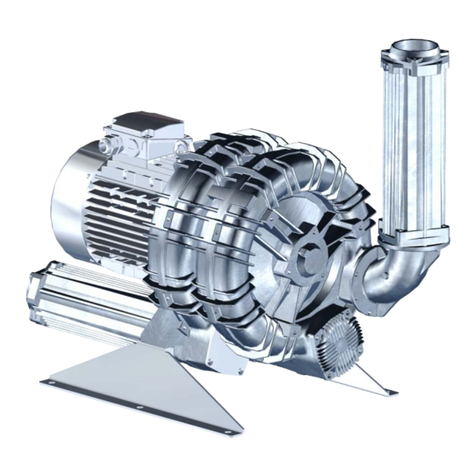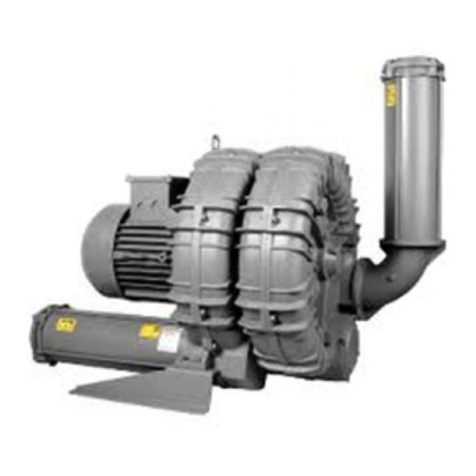
1. ISTRUZIONI GENERALI
1.1 NORME DI SICUREZZA
ATTENZIONE!
I compressori - aspiratori a canale laterale ‘SCL K’ per
categoria 3GD sono apparecchiature del gruppo II, per
l’uso in zone classificate con presenza di gas, vapori
e/o polveri combustibili non conduttive (zona 2 e zona
22). Essi sono progettati e costruiti in accordo alla
Direttiva ATEX 94/9/CE, Gruppo II Categoria 3GD,
secondo le norme europee EN 1127-1, EN 13463-1, EN
13463-5 e EN 14986.
Sono adatti al trasporto di gas se nelle condizioni di
funzionamento, la presenza di atmosfera esplosiva è
improbabile. Se ciò accade deve essere di breve durata.
Nel valutare la categoria dell’apparecchio, la parte
interna della macchina deve essere considerata come
l’ambiente in cui è installata.
I compressori/aspiratori a canale laterale ‘SCL K’
devono essere installati e mantenuti in accordo con le
norme impiantistiche e di manutenzione per ambienti
classificati contro il rischio di esplosione per presenza
di gas, vapori e/o polveri combustibili non conduttive
(zona 2 e zona 22) (esempio: EN 60079-14, EN 60079-17,
EN 61241-14, EN 61241-17 oppure altre norme/standard
nazionali).
Come tutti i macchinari e le apparecchiature con parti
in moto o poste sotto tensione, possono essere fonte di
grave pericolo se non propriamente utilizzate e/o
protette.
Viene demandato all'utilizzatore garantire che:
Tutte le operazioni di trasporto, montaggio,
installazione e allacciamento vengano eseguite da
personale qualificato, intendendo quel personale che
per formazione, istruzione, esperienza, come per
conoscenza di norme, prescrizioni, provvedimenti
antinfortunistici e condizioni di utilizzo e servizio, sia in
grado di effettuare ogni intervento necessario
riconoscendo ed evitando ogni possibile pericolo e/o
danno.
E’ SEVERAMENTE VIETATO:
- Utilizzare la macchina in installazioni non
industriali a meno che non siano state prese tutte
le precauzioni necessarie o misure protettive;
- utilizzare la macchina in luoghi dove la presenza di
polveri esplosive avvenga per un lungo periodo di
tempo o frequentemente;
- utilizzare la macchina in luoghi dove la presenza di
polveri esplosive è costante;
- l’aspirazione ed il trasporto di mezzi esplosivi,
infiammabili, aggressivi, corrosivi e/o nocivi;
- utilizzare la macchina in condizioni diverse dai
valori riportati nella targa prodotto;
- Il funzionamento a bocca chiusa dell’aspirazione
e/o della mandata;
- apportare modifiche o trasformazioni sulla
macchina, lavori di riparazione o manutenzione che
richiedono lo smontaggio della stessa.
Il personale esecutore delle operazioni di trasporto, montaggio,
installazione e allacciamento deve disporre di tutte le istruzioni
ed informazioni del caso, comprese eventuali prescrizioni locali e
a queste si deve attenere per lo svolgimento di qualsiasi
operazione.
Qualsiasi operazione anche indiretta su macchine ed apparecchi
è interdetta al personale non qualificato.
Devono venire soddisfatte in fase di installazione tutte le misure
di prevenzione prescritte, comprese eventuali prescrizioni locali
e/o particolari, e ne viene inibita la messa in servizio prima che le
macchine che le incorporano siano dichiarate conformi alla
Direttiva Macchine CE.
Si consideri che, esaminate le peculiarità costruttive e funzionali,
tali unità:
- in condizioni di esercizio possono raggiungere temperature
superficiali elevate, fino a 125 °C;
- non sopportano pressioni interne elevate, comunque non
superiori al valore Ps int max riportato nella targa prodotto;
- sono soggette a piccole perdite del fluido convogliato;
- possono presentare una rumorosità non accettabile per
determinate condizioni di installazione.
Gli accessori collegati all’unità devono essere conformi alla
direttiva ATEX 94/9/CE, il collegamento e le condutture di
aspirazione e mandata in materiale metallico o antistatico.
L’utilizzatore deve:
- Predisporre all’aspirazione un adeguato filtro in materiale
antistatico della categoria corrispondente, in accordo alla
Direttiva 94/9/CE, con grado di filtrazione massimo 25µm,
perdita di carico massima ∆P = 15mbar;
- deve valutare l’efficienza del filtraggio;
- deve eseguire un controllo periodico per effettuare la
pulizia o la sostituzione dello stesso.
I compressori - aspiratori ‘SCL K’ per categoria 3GD devono
essere collegati a terra mediante apposito elemento di
connessione antiallentante ed antirotazione; collegare a terra il
motore elettrico mediante il proprio collegamento di terra.
Il motore elettrico non deve essere aperto sotto tensione.
Al fine di limitare la formazione di strati di polvere, provvedere
alla regolare pulizia ed alla loro rimozione con idonee
attrezzature.
ATTENZIONE!! Non pulire la targhetta prodotto con solvente e/o
sostanze aggressive.
Pulire periodicamente la ventola di raffreddamento del motore per
evitare il surriscaldamento dello stesso.
All’utilizzatore non è permesso eseguire riparazioni o
manutenzioni, che richiedono di smontare la macchina.
In questi casi richiedere l’assistenza FPZ o quella del ns.
rivenditore.
Prima dell’installazione leggere attentamente quanto riportato in
questo manuale di istruzioni.
1.2 CONDIZIONI DI UTILIZZO
I compressori - aspiratori ‘SCL K’ per categoria 3GD sono adatti al
convogliamento in servizio continuo di aria e gas non esplosivi, non
infiammabili, non aggressivi, dove la presenza di atmosfera esplosiva
è improbabile.
Corpi solidi anche di piccole dimensioni e sporcizia possono causare
la formazione di scintille, dovute allo sfregamento delle stesse tra la
girante e la carcassa.
Anche i depositi di polvere all’interno della macchina possono
provocare la medesima reazione, e di conseguenza un aumento della
temperatura di esercizio.
Inoltre, la loro presenza può provocare la rottura delle palette della
girante, rendendo pericolosi i frammenti che vengono espulsi dalla
soffiante.
IMPORTANTE!
Predisporre all’aspirazione un adeguato filtro in materiale
antistatico della categoria corrispondente, in accordo alla
Direttiva 94/9/CE, con grado di filtrazione massimo 25µm,
perdita di carico massima ∆P = 15mbar.
I differenziali massimi di pressione ammessi (∆Pmax indicati nella
targa prodotto) non devono mai essere superati.
EVITARE ASSOLUTAMENTE IL FUNZIONAMENTO A BOCCA
CHIUSA.
Proteggere con adeguata valvola di sicurezza della categoria
corrispondente, in accordo alla Direttiva 94/9/CE.
Le caratteristiche sono soggette a variazione in funzione dei seguenti
fattori:
- variazione della pressione assoluta di aspirazione o di scarico
rispetto alla condizione di riferimento (1013 mbar);
- funzionamento a sistema misto (depressione in aspirazione e
contemporanea contro-pressione in mandata);
- convogliamento di gas avente peso specifico e/o temperatura
diversi dai dati di riferimento (1.23 kg/m3; 20 °C);
- variazione della velocità di rotazione rispetto al valore di
riferimento.
La temperatura ambiente, come la temperatura di aspirazione del
fluido convogliato, é ammessa nel campo di -15 ÷ +40 °C.
Va sempre assicurata una buona ventilazione delle unità
particolarmente se sottoposte a condizioni di esercizio gravose.
Le unità sottoposte a frequenti avviamenti o ad elevate temperature
ambientali possono essere soggette a problemi di surriscaldamento.
I - 6/39
ENERGOEKONOM
spol.
s
r.o.,
Wolkerova
433,
CZ-250
82
Úvaly,
Czech
Republic,
Tel.:
+420
281
981
055,
[email protected],
www.energoekonom.cz

